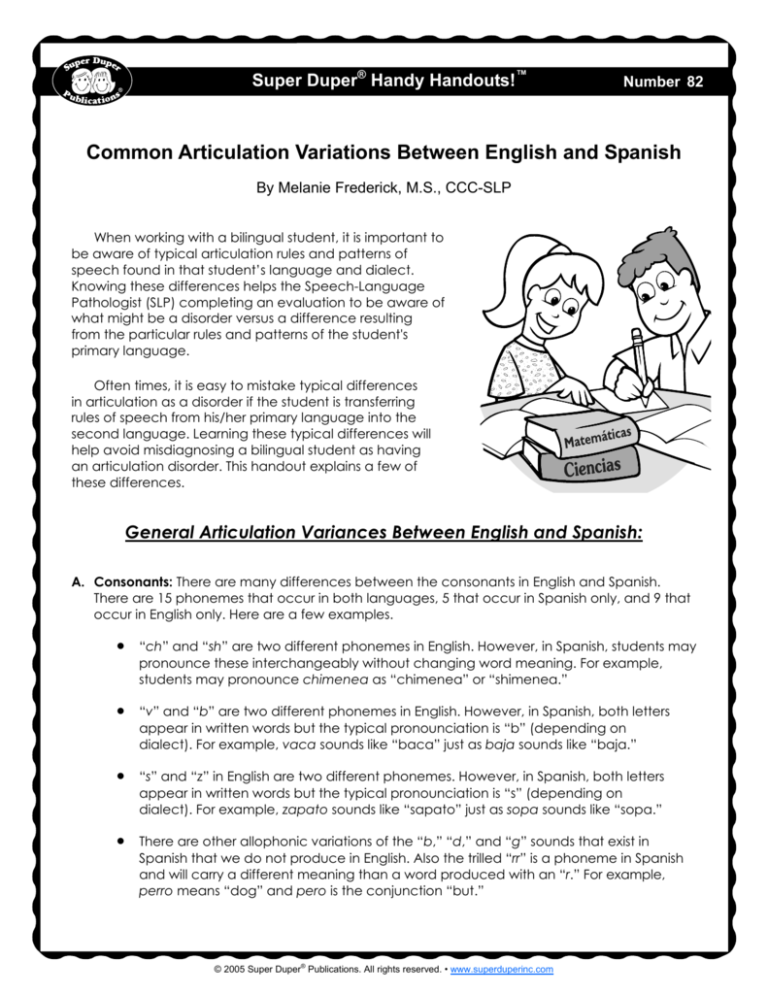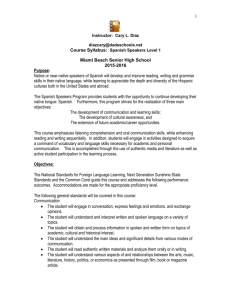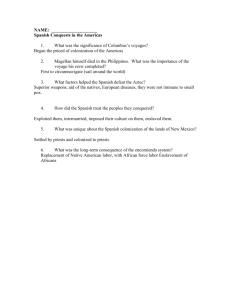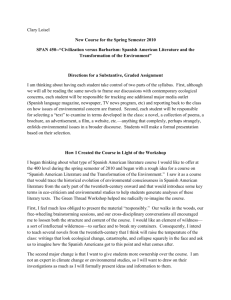
Super Duper® Handy Handouts!™
Number 82
Common Articulation Variations Between English and Spanish
By Melanie Frederick, M.S., CCC-SLP
When working with a bilingual student, it is important to
be aware of typical articulation rules and patterns of
speech found in that student’s language and dialect.
Knowing these differences helps the Speech-Language
Pathologist (SLP) completing an evaluation to be aware of
what might be a disorder versus a difference resulting
from the particular rules and patterns of the student's
primary language.
Often times, it is easy to mistake typical differences
in articulation as a disorder if the student is transferring
rules of speech from his/her primary language into the
second language. Learning these typical differences will
help avoid misdiagnosing a bilingual student as having
an articulation disorder. This handout explains a few of
these differences.
General Articulation Variances Between English and Spanish:
A. Consonants: There are many differences between the consonants in English and Spanish.
There are 15 phonemes that occur in both languages, 5 that occur in Spanish only, and 9 that
occur in English only. Here are a few examples.
•
“ch” and “sh” are two different phonemes in English. However, in Spanish, students may
pronounce these interchangeably without changing word meaning. For example,
students may pronounce chimenea as “chimenea” or “shimenea.”
•
“v” and “b” are two different phonemes in English. However, in Spanish, both letters
appear in written words but the typical pronounciation is “b” (depending on
dialect). For example, vaca sounds like “baca” just as baja sounds like “baja.”
•
“s” and “z” in English are two different phonemes. However, in Spanish, both letters
appear in written words but the typical pronounciation is “s” (depending on
dialect). For example, zapato sounds like “sapato” just as sopa sounds like “sopa.”
•
There are other allophonic variations of the “b,” “d,” and “g” sounds that exist in
Spanish that we do not produce in English. Also the trilled “rr” is a phoneme in Spanish
and will carry a different meaning than a word produced with an “r.” For example,
perro means “dog” and pero is the conjunction “but.”
© 2005 Super Duper® Publications. All rights reserved. • www.superduperinc.com
B. Vowels: There are only five vowels found in the Spanish language. There is no unstressed schwa / ə / as
found in the English word “above.” This is very different from the 30+ vowels found in English. Spanish
speaking children may substitute a tenser vowel for the unstressed vowels in an English word. Also, in
addition to diphthongs, triphthongs are also common in Spanish (though not typically found in English).
•
The following are the five Spanish vowels:
•
•
•
•
•
/i/
=
keep
/e/
=
made, vet
/a/
=
cot
/u/
=
you
/o/
=
sew
C. Syllables: Spanish is a syllabic language. This language has syllables that fall within and between words. Each
syllable has the same duration, no matter where the stress in the word may fall. This is often why many
English speakers may perceive Spanish speakers as “rapid” talkers. In contrast, English has an accentual
rhythm of speech in which the accented syllables have a longer duration than the unaccented syllables.
For example, “I stayed a while” has two accented areas of stress that have a slightly longer duration than
the other sounds in the sentence.
D. Pitch: In Spanish, pitch does not vary as it does in English. Therefore, a student whose primary
language is Spanish may sound monotone when speaking English.
E. Accent: In Spanish, placement of an accent on a word may change the meaning. For example:
Camino = (1st person present tense) “I walk.”
Caminó = (3rd person past tense) “You (formal)” or “He/She walked.”
F.
Dialectal Variations: It is important to note where the Spanish student is from because, depending
upon the student’s region/country, there will be different types of variations and substitutions
common to his/her dialect. Articulation and language differences occur in different countries. For
example, some Caribbean (i.e., Puerto Rico and Cuba) communities will simply delete the final / s /
in words. An example would be los amigos produced as “lo amigo.” This will have an effect on
articulation, as well as language. Students may carryover this final / s / deletion into English.
Spanish speakers with a Castilian dialect may produce the “th” sound in place of the / s /. For
example, cena would sound like “thena” in certain dialects. This occurs only in parts of Spain and is
not typical to Spanish speakers from any other country.
Knowing these and other dialectal variations will help the SLP determine if the student is exhibiting
disordered articulation or simply differences in pronunciation based upon his/her primary language.
Resources
Goldstein, Brian A. (2004) Bilingual Language Development and Disorders In Spanish-English Speakers. Baltimore: Paul H.
Brookes Publishing Co.
Teschner, Richard V. (2000) Camino Oral: Fonética, fonología, y práctica de los sonidos del español. 2nd Edition. Boston:
The McGraw-Hill Companies, Inc.
Barrutia, Richard and Schwegler, Armin (1982) Fonética Y Fonología Españolas. 2nd Edition. New York: John Wiley & Sons, Inc.
© 2005 Super Duper® Publications. All rights reserved. • www.superduperinc.com










